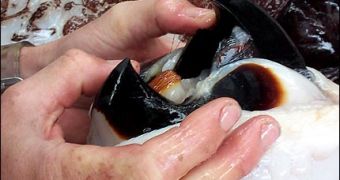A squid is like a mass of gelatinous tissues. Still, its razor-sharp parrot-like beak is one of the toughest natural materials. The beak of a jumbo squid can sever the nerve cord of a large fish, paralyzing it, and they can do this to divers as well. But each time they bite, powerful forces exert pressure on the soft tissues at the base of the beak. A new research published in the journal "Science" explains how a jumbo squid's hard beak can tear off prey tissues without damaging the tissues of the squid.
The team led by Ali Miserez at the University of California, Santa Barbara, analyzed the beak samples taken bit by bit, from tip to base, and found varying percentages of chitin (the tough sugar polymer found also in the exoskeleton of insects, scorpions, spiders and crustaceans), water, and proteins in the matrix of the beak. The overall stiffness level varied 100 times from beak tip to base.
Towards its base, the beak gradually turns softer while approaching the soft muscle tissue. This research could come with new ideas for the tricky issue of mechanical attachment of soft and hard materials without damaging the soft substance. At the moment, there are many limitations in this domain.
"What we find responsible for the high hardness and stiffness of the beak tip is a high density of strong chemical bonds between the proteins in the beak. The beak's tip is stronger and stiffer than any synthetic polymers. It's remarkable that the squid beak comprises strictly organic materials, In contrast, mammalian teeth contain up to 90% minerals," said Miserez.
Water too was found to be involved in controlling the stiffness of the beak. The protein of the matrix has high amounts of two amino acids: histidyl and Dopa, a powerful glue. Dopa is involved in some of most powerful natural adhesive systems, like the dentino-enamel join of mammalian teeth, the arthropod exoskeleton, geckos' sticky feet, and mussel byssal threads.
This amino-acid has a high affinity for certain metals and "strongly adheres to both organic and inorganic surfaces," said Phillip Messersmith of Northwestern University, in Evanston, Illinois.
Materials scientists investigate the potential use of Dopa as a wet/dry adhesive in polymer coatings.
"If we could reproduce the property gradients that we find in the squid beak, it would open new possibilities for joining materials. For example, engineers could create a robust bond if they made a graded adhesive with properties to match one material on one side and a different material on the other side," said co-author Frank Zok.
There is also an ecologist side of the issue.
"Biological materials are 'made' by animals at the temperature of oceans and using naturally occurring chemicals. If we can fully understand the chemistry and copy it, then that could lead to a generation of synthetic materials that are less harsh to the environment and made at milder energetic conditions," said Miserez.

 14 DAY TRIAL //
14 DAY TRIAL //